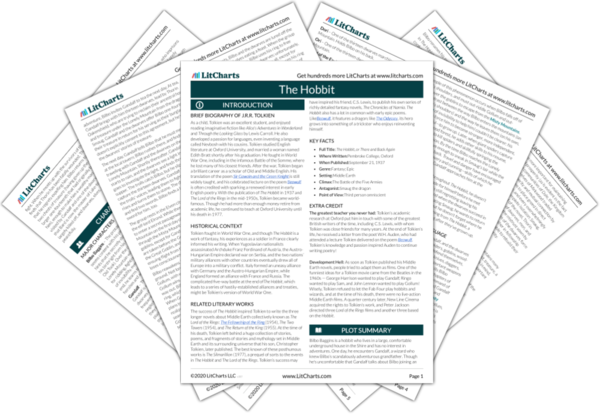Summary
Analysis
The group walks through the Misty Mountains, and their path is difficult and dangerous. As they climb high up, they can see back to the West, back in the direction of Bilbo’s home, the Shire. Bilbo thinks longingly of the harvests taking place in the hobbit-lands.
Bilbo continues to think of his home. He’s connected to the land itself—to the rituals of harvesting—as much as he’s connected to specific people and places. But he has also traveled far, and can see his former home in a new way.
Themes
Gandalf knows that the Misty Mountains have become full of danger in recent times, and that underneath them, in the Mines of Moria, there are goblins. One night, a thunderstorm breaks out, and the Mountain Giants throw rocks to each other for fun. Fili and Kili, the two youngest dwarves, find a cave that can provide shelter from the storm—Gandalf asks them if they’re sure the cave is empty, and though Fili and Kili have come back too quickly to be at all sure of this, they insist that it is. The group goes into the cave; Gandalf forbids them from lighting a fire. They rest.
Gandalf’s questions about the emptiness of the cave foreshadow danger to come. That Fili and Kili insist the cave is empty attests to their own inexperience as adventurers but also for the urgent need of finding shelter—a temporary home—from the brutal force of nature embodied in the storm. Also, as readers, the story gives us enough detail to know that going into the cave is a bad decision and will lead to danger, but at the same time, we want them to get into trouble—we don’t want another series of uneventful weeks, as the dwarves just experiences in Rivendell. As readers, we have some of the same “dual nature” as Bilbo: longing for the characters safety, while also longing for them to have adventures.
Themes
In the middle of the night, Bilbo wakes up to a creaking sound, and sees a crack growing in the side of the cave, from which goblins emerge. Bilbo gives a cry, waking up Gandalf and allowing him to vanish in a flash of light that kills several goblins. The goblins seize the group’s ponies, which they will later eat, and take everyone but Gandalf prisoner. Goblins, the narrator notes, are clever, evil creatures who bear Thorin’s people a special grudge because of the wars they’ve fought with each other.
Bilbo isn’t powerful or resourceful enough to fight the goblins, but he does demonstrate his value to the group by noticing them—Bilbo may not be a warrior, but he is alert and clever. The narrator establishes a long-running conflict between dwarves and goblins—a history or “birthright” of war—which will continue to be important in the rest of the book.
Themes
The goblins lead Bilbo and the dwarves to their leader, the Great Goblin. The Great Goblin asks Thorin to identify himself and explain why he’s here; Thorin identifies himself, but lies and says that he and his group are visiting his relatives on the other side of the mountain. The goblins howl that Thorin is lying, and that he hasn’t explained the bright flash of light that killed some of them. They also produce the sword Thorin found in the troll’s treasure hole, which the Great Goblin immediately recognizes as Orcrist, or Biter, a famous sword that has killed hundreds of goblins.
Thorin doesn’t lie and give a false name to the Goblin King—it’s as if he’s too proud to conceal his identity, even as he refuses to reveal the purpose of his travels. Thorin is a warrior, and he acts according to a warrior’s code of honor, but without all that much cleverness. In this section, Bilbo begins to get a sense for battle and violence—not only the people who participate in them, but the trophies and relics of battle, such as Orcrist.
Themes
Get the entire The Hobbit LitChart as a printable PDF.

The Great Goblin gives a howl of rage at the sight of Orcrist, but at this exact moment, the lights go out. A bright sword appears to float through the room, and kills the Great Goblin. A voice tells the dwarves to quickly follow it away from the goblins. As the dwarves run away, Gandalf lights his wand, revealing himself to be the bearer of the sword, which is called Glamdring the Foe-Hammer.
At this point, Gandalf’s powers are more obviously magical—he can extinguish light, see in the dark, etc. He also excels at old-fashioned sword-fighting, and kills the Great Goblin with apparent ease. In this way, we begin to see the full extent of Gandalf’s abilities: he uses words, weapons, and magic with equal skill.
Themes
The dwarves run, but the goblins are faster, and Gandalf tells Thorin to turn and fight. Using Glamdring and Orcrist, Gandalf and Thorin kill many goblins, then turn back and continue running away. Bilbo thinks to himself that he was wrong to ever leave his hobbit-hole. Dori is carrying Bilbo on his back as they run from the goblins, but when a goblin tries to grab Dori, Bilbo rolls off his back and falls deep into a cavern, hits his head on a rock, and loses consciousness.
In the midst of the first big danger the group faces, Bilbo is too inexperienced to be of much use—in fact, he’s so useless that Dori carries him on his back like a child. In moments such as this, Bilbo wishes he were back at home, demonstrating how unprepared he is for the challenges of adventure.
Themes












